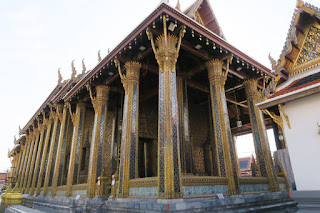Travel outside of Thailand is not encouraged because of this plandemic so I decided to act like a tourist and stay in country. There was a part of me that also wanted to see how much staying in a hotel and taking a tour has changed from previous 'virus years'. While I had to be mindful of wearing a mask in certain locations, I am happy to report that not much else has changed.
When visiting the Grand Palace, visitors notice that it is located in an old area of Bangkok -- understandably, since it was built approximately 250 years ago. The following are some examples of streets and buildings leading up to the palace grounds.
In essence, the Grand Palace as we know it, is not a single structure but a royal complex made up of numerous buildings, halls, pavilions set around open lawns, gardens and courtyards. During the time of the absolute monarchy, from Bangkok's founding in 1782 until the 1932 revolution, the Grand Palace was the complete center of government. The king acted as prime minister, and thus had many royal scribes, jurists and other government officials around him.
- The Temple of the Emerald Buddha is the royal chapel and home of the emerald Buddha
- The Middle Court houses the most important state apartments and ceremonial throne halls of the king
- The Inner Court, at the south end of the complex, was reserved only for females like the king's harem, and
- The Outer Court is in the northwestern part where royal offices and state ministries existed
It is important to note that many Rama (kings) constructed a building in efforts to leave their legacy. Only the current king can gain access to these buildings in the complex today.
Temple of the Emerald Buddha
There is a royal chapel situated within the walls of the palace that has all the features of a temple -- typical of Thai architecture -- except there are no living quarters for monks. I learned that buildings clad with porcelain came from China which was part of trade with Thailand. In return, Thailand provided them with rice and teak wood.
Dragons located by doors and gates were to protect visitors and residents against evil spirits. Visitors will notice 120 small figurines guarding the Emerald Temple and the elements (water, fire sticks, etc) are still located outside so as not to disturb those praying inside.
I learned that different colored tiles on building roofs represent varying elements, such as:
- Red or orange for rice fields
- Yellow or gold for prosperity, and
- Blue or green representing nature and ability to produce

Middle Court
The largest and most important court is the Middle Court and is considered the main part of the Grand Palace where the most important residential and state buildings are located.
The lower floor is now a weapons museum, an area that most likely held weapons before going to war in the days of old. I was told the middle floor holds formal dinners for royalty and upper floor holds Buddha relics collected over the years.
My tour guide pointed out that the platform is raised at just the right height so the king could easily mount and dismount from the elephant's back.
Inner and Outer Courts
Historically the Inner Court was a town complete within itself, divided by narrow streets and lawns. It had its own shops, government, schools, warehouses, laws and law courts, all exclusively controlled by women for the royal women. Men on special repair work and doctors were admitted only under the watchful eyes of its female guards. The king's sons were permitted to live inside until they reached puberty; after their tonsure ceremonies they were sent outside the palace for further education. There are currently no inhabitants within the Inner Court and the buildings within are not used for any purpose; nevertheless, the entire court is closed to the public.
The Outer Court include the headquarters and information center of the Grand Palace. This is where palace guards, taken from the Royal Thai Army, get their assigned duties and congregate between shifts. Visitors observe numerous guards posted around palace grounds providing ceremonial as well as practical security to the palace compound.
On our way out of the palace grounds, the security guards at the gate asked my tour guide if she brought them anything for good luck since it was the new year. Wannakan (name of my tour guide) had candy that she bought in Chiang Mai the day before so she gave each guard a piece. Giving guards an offering is customary in Thailand so this was no surprise to my tour guide that they would ask!
On our way out of the palace grounds, the security guards at the gate asked my tour guide if she brought them anything for good luck since it was the new year. Wannakan (name of my tour guide) had candy that she bought in Chiang Mai the day before so she gave each guard a piece. Giving guards an offering is customary in Thailand so this was no surprise to my tour guide that they would ask!





